Schooldays: Dear Old Golden Rule Days!
The values embodied in sayings such as “The truth prevails” and “Never Betray a Trust” taught in the schoolroom at the turn of the century were to become an integral part of everyday life, shaping community attitudes of those who lived in the area now known as Kingston in the early years after Federation.
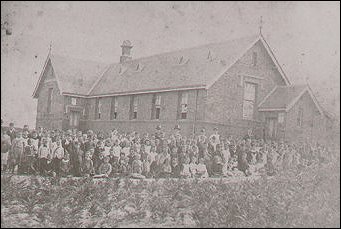
Pupils and teachers gather outside the Cheltenham State School, c1900.
Many children were born into large families, which were poor. Earning a living on the land was tough and the children were needed as soon as they were able, to help run the family concern. There were few schools in the area, and no transport. For children this usually meant a long walk through dirt tracks, or just scrub and sand, summer and winter, with chores to be done before making their way to school. Parents were concerned, and active in bettering conditions for their children. Schools, such as Carrum, were established through applications, with reports from Departmental inspector to support their claims.
At Carrum, during the wintertime, McLeod Road was almost impassable because of its mud, and in summer it was infested with snake so an application was made for a new school near the station. A letter dated September 24, 1900, from the Education Department noted its agreement to establish a school at the Wesley Church for a rent of five shillings a week. [1]
Kath Kirkcaldy thinks that the Dingley school, which started off with about 20 pupils in 1925, would have come about through the district inspector’s sympathy for the children from Dingley. They had to go to the Heatherton School, she says, but it was a good two and a half miles walk, and the inspector must have realised that there was nothing in between. He approached the Education Department, she believes, to propose that if the parents could get a school committee going; acquire some land and build a school, the Department should provide the staff for Dingley. Subsequently, the Gartside Brothers she says, donated the land for the school, which was just two rooms divided with a partition, and a little entrance hall; cloakroom and a storeroom down the end - a simple, rectangular affair- she recalls. [2]
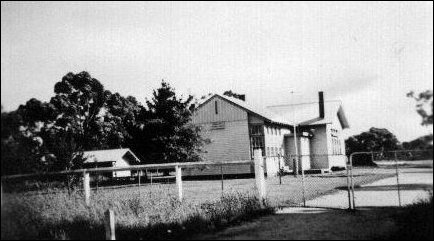
Dingley School, 1950. Courtesy of Dingley and District Historical Society.
Schooldays were not for long, however. Children would normally stay at school until they had their Merit Certificate, at around 14 years, or even earlier. Only people with money could afford to send their children to High School after the sixth grade. All others would stay at Primary School until grade eight. The fact that the few High Schools which children could attend at the time, were at Mordialloc (1924), Dandenong (1919) and Frankston (1924), would have been another stumbling block to any individuals with ambitions of attaining a higher education. Joyce Peterson believes that the lack of transport in the district, as much as poverty and parental pressure, influenced the children to work at home after leaving school. [3]
Most parents thought that it was sufficient for their children to be able to read, write, and do basic arithmetic, for survival on the land. Some children who really loved school of course, suffered from this attitude. Alf Liddell recalls that he was taken from school at 13 to help at home, before he had even finished his Merit Certificate. That did not stop him from being successful in business ventures later on, but at the time, he was really upset. “You knew you were going to get a dead end job because you weren’t going to be educated. You knew you’d be in a shop, or a factory. I ended up in a factory… But then I’ve had 3 or 4 businesses, done well…” [4]
There was no conscious training for a vocation during the years leading up to the Merit Certificate. Bob Wright remembers that the two most important subjects at State School were Arithmetic and Writing, and that at the end of schooling, you took any job you could, if you were indeed lucky enough to get one. “I don’t remember it being brought up to me about any particular occupation” he says. [5]
Bob Robertson remembers that his mates could barely wait until they were 14 and able to leave school, and comments that apart from the really smart children, the majority of them were dying to get home on the land. “Everybody was milking cows. Everybody had a herd of cows. They were dying to be fourteen. Turn 14, you were right.” he says. [6]
Those who went on with their schooling - the smart children in the district - seemed destined to become teachers. Teacher training was applied for after attaining the Merit Certificate. Aspiring teachers such as Myrtle Squire had already been assigned monitorial duties within the school. This helped to reinforce her career choice. “School was growing in numbers and I had a lot of experience in monitoring work with children who had missed school because they were sick, and those who found it difficult to learn. The headmaster used to get me to bring the children up to date,” she says. [7]
After gaining her Merit Certificate in 1912, Miss Squire went to Melbourne High School in 1914, and was qualified to sit for the Junior Public School Examination, which she passed at the end of the term. She was able to go on for two years more, as that was all her father could afford. Her first appointment to Tallangatta, ‘Sandy Creek Upper’, was by contract for two years, but due to the fact that her mother was very ill, she was able to transfer back to her own primary school at Cheltenham as a First Class Junior Teacher. [8]
Teachers were held in high regard where they reflected the general community values of dedication to hard work, discipline and responsible service to the community. Many taught in Sunday Schools as well as taking huge classes during the week, in a multi-grade system. Some, who began their careers in the district, were to remain there throughout their working life.
Len Allnutt, who attended Cheltenham Primary School from 1927, has this to say about teachers whom he remembers from his schooldays. “Mr. Gleeson was a tall, thin red-headed man. School was his life. The thing he always drove into the children was that the truth prevails, truth above everything else, and that you never betray a trust. The Infant Mistress was Miss Burville. She taught for many years at the Cheltenham School, and she was not only in charge of the Infant Section but she was known then as the 1st Assistant. That was the highest a woman could go in those days in the Education Department. She was a dedicated teacher, she had a First Aid Certificate, and she told my mother that when she came to Cheltenham School, nobody had any knowledge of First Aid, and she didn’t think that was right, although there was a doctor right alongside the school, and she went and she got the Certificate, so if any child was hurt or anything, they would go to Miss Burville. She had a First Aid Cupboard, and she taught children, parents and grandchildren, and although she was a strict teacher, outside of the classroom she was always pleased to see any past pupils and crack a joke with them. She was well known in the district, and she was well liked. When she retired from the Education Department, she took a job teaching migrants, and she taught the migrants English well into her eighties”, he says.
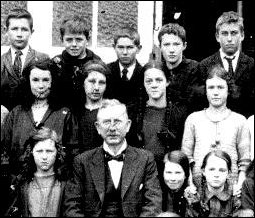
Mr Michael Gleeson, Head Teacher of Cheltenham Primary School, 1918 to 1928 with students from Grades VII and VIII.
“There was another teacher, Miss Squire, who taught for many years,” he adds. “She lived in Charman Road Cheltenham, and she couldn’t leave Cheltenham for family reasons, so she continued to teach at the school. Any of the teachers who wanted to know anything about the children, or anything local, they would go to Miss Squire. Miss Squire, and Miss Burville were close friends, teaching together for so many years, and Miss Squire not only taught school, but Sunday school as well. When I started Sunday school, she was in charge of the Kindergarten. When I got to the top of the Sunday school, she had the Girls’ Bible Class. They had the boys and the girls strictly segregated in those days. Myrtle Squire lived to be 100, ” says Len. [9]
Past pupils mention Mr. Matthews, headmaster of Heatherton School, with respect and affection. Joe Souter, whose mechanical genius and ability to solve problems made him a great success in the Springvale community, says that he got more out Matthews’ style of teaching than from any teacher who would try and hammer facts into him. He was very progressive, Joe recalls, and whereas others might preach cleanliness, Mr. Matthews had troughs and taps installed, and provided soap and water so that the pupils could wash their hands properly before handling their exercise books. The children responded to this teacher, Joe says, because he genuinely encouraged pupils to ask for an explanation if they did not understand anything, as often as they needed to. Joe says he was strapped for doing just that, when he went on to Caulfield Technical School. He was so disillusioned by this, he remembers, that he could hardly wait to leave there. [10]
Frank Baguley recalls that Mr. Matthews had set aside an area of land at the side of the school, and all those in the two top grades interested in gardening were allocated a plot each. Now Frank, who started the Flower Growers Association, successfully breeding virus free plant stock for flower growers here and interstate, hated composition; liked spelling; loved arithmetic and was a whiz at gardening. So much so that he won first prize for his veggie patch in his seventh year at Heatherton. The early training with figures and gardening, he concedes contributed to his later business success.[11]
Some teachers in the district stayed long enough to teach several generations of the same family. Sylvia Roberts remembers that Miss Burville taught her mother’s youngest brother, and eight of the children in her family as well as her eldest brother’s children. She was a really dedicated teacher, says Sylvia, but the fact that Miss Burville had taught her older siblings was not always to her advantage. “You’d only be new to her, and she’d say, to you… ‘you’re not a patch on your brother!’ Well how could I be? She was just going to start with me, and she’d just finished with him. The whole family copped it. When she taught my eldest brother’s children until they left there, she must have been really old,” she says.[12]
“Miss Burville taught my father, me and my brother and then retired”, adds Kingston City Historian Graham Whitehead, who attended the big farewell for her at the Soldiers’ Hall in Cheltenham. He thinks this was in 1954, and says that he actually drove her home from the bash to Glenhuntly as an unlicensed driver, and lived to tell the tale.
Sylvia Roberts marvels at another of her favourite teachers, a Miss McGee, who organised the 62 pupils in her Grade 3, so that the ones who were not so bright were seated in two rows where she was able to help them all the time. The more clever pupils, she remembers, sat on the outside all the time, and they didn’t get so much attention. She wonders how Miss McGee did it when teachers today are complaining about having 25 children in the room.[13]
The curriculum was much more regimented and straightforward then, with emphasis on rote learning and class recitation, rather than individual learning. There were textbooks for English, Arithmetic, History and Geography, and Handwriting was taken very seriously. Bob Wright reflects that at first they used a slate and a slate pencil, and later, they had a copybook, ruled for small and large letters. This early training prompts his grand-kids to remark, especially when he does business, that ‘we can always read your writing’, he says. [14]
As far as Betty Souter is concerned, learning by rote and chanting tables was no drawback to her education. “It made it stick in the brain, then. Now a lot of kids can’t spell or can’t add up or that, but we had to do it over and over again, every morning, with spelling or arithmetic. Mental Arithmetic I was good at that. You’d work it out in your head before they’d finish,” she says. [15]
Apart from the 3 R’s, the curriculum included sport, gardening, and “nature walks”, reports May Keeley. The classes would walk down the roads through the bush, observing what wildflowers were in bloom, or what birds were around and notice when the wildflowers were out, she says. In those days, she says they were allowed to pick them, and there were a lot of Spider Orchids and Greenhoods, which they would take back to the classroom for nature drawing and discussion. She also remembers that for geography lessons there was none of this tracing from a map from Coles or somewhere or other… they had to do it by hand. “You drew inch squares,” she says, “and you put it into sections like the Headmaster did on the board.” [16]
Things were tough for children who did not conform to the rules, at school. Physical beatings were administered with a strap, ruler over the knuckles or even the hefty rosary beads worn by nuns in Catholic Schools. Bob Wright remembers that the teacher always had a strap to remind those who were out of order, to take notice of what they were being taught. “We were to become better citizens,” he says. [17]
Ken Smith remembers that the headmaster of Cheltenham school, Mr. Michael J. Gleeson, a very stern man, used a big, thick piece of horse harness for a strap. He recalls an incident in which the 14-year-old boys used to go to a very big swamp where the Golf links are now in Cheltenham. The big boys, and of course, Ken, would set fire to the dry bulrushes there, and then they would eagerly wait for the Fire Brigade to come. They would get back to school late where unfortunately there were nasty consequences to face. Ken remembers “Gleeson would line us all up along the big long passageway in Cheltenham, and go right down the line belting, BANG. Now the children who were good at it… you had to hold out your hands… let their hand fall with the strap, and so the strap didn’t hurt so much, but silly little boys like me kept our hands out and it hurt!” [18]
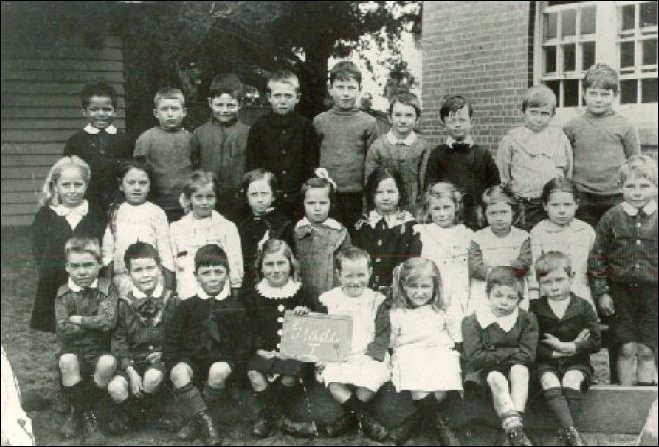
Grade One at Cheltenham Primary School. Ken Smith is third from left in front row, c1918.
Len Allnutt confirms that Mr. Gleeson was very strict. “He used to hoe into the children,” says Len. “In fact, all the teachers were very free with the strap. The 3R’s were the thing they drummed into you.” He goes on to remember that when the good name of the school was tarnished on an excursion to the zoo, there was swift retribution for the culprits. He recalls that there was a wild child in the group, one Snowy Bates. Snowy, he says, was up to any sort of lark that was going, and while at the zoo, he spotted a porcupine, immediately jumped in, and started pulling out its quills. Several other children thought this was a great idea, and joined him. They took the quills, brought them to school the next day, and stuck them on their pens. Unfortunately for Snowy and his mates, somebody from the zoo had contacted the school to complain that the Cheltenham children had been spotted pulling out the quills from their now near-nude porcupine. “Well,” says Len, “the headmaster, old ‘Boss’, came out, and any kid found with a porcupine quill in his pen was marched up and they each got six cuts from Mr. James.” [19]
Girls fared better than the boys, it seems in matters of discipline. Bob Wright says, “The girls would get a tap on the backside; the boys would get it on the hand. [20] Tess Bone went to St Bridget’s College, which is now known as Kilbreda. She remembers that a very thin, very small, wiry sort of a nun, belted the boys with her hefty set of Rosary Beads. But she also recalls that the same nun was adept at getting all the pupils to perform to perfection for the Annual Ball, despite the fact that she could only play the piano with one finger. “She’d have them perfect by the time the Annual Ball came in - whatever they had to do, whether it was the Lancers or the Alberts, she’d have them perfect”, Tess says with admiration. [21]
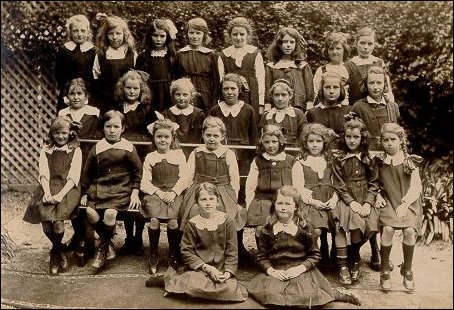
Composite class at Kilbreda College, c1919. Courtesy Amelia Henderson.
Other than instilling obedience, pride in their work and respect for the good name of their school, teachers also strove to create a feeling of national pride in the pupils. Bob Wright recalls that being Australian was made important then. It meant observing special days to celebrate the honour of the nation, something we no longer do, he regrets to say. “Once a week you saluted the flag, and Australia Day was a very important day. It was to teach us about Australia and make us think about it. Generally there were little gifts handed out with an Australian flag on them, and sometimes there was time off to go to a movie about Australia Day. There was always a ceremony at school,” he says.[22]
Len Allnutt describes Empire Day ceremonies, too. Len remembers that Mr. Everest Le Page, who was President of the school committee at Cheltenham, and Mr. Courtney, a chemist who had the dispensary opposite the school, would come to the school with a clothes basket full of boiled lollies, and give them out to all the children to commemorate the grand occasion.[23]
Sylvia Roberts remembers the daily ceremonies. “We had to say the oath- I love my King and my Country, and obey my Teachers, Parents and the Laws, and put our hands on our hearts, and salute the flag.”
The oath, for the record, was:
I love God and my Country,
I will honour the flag,
I will serve the King,
And cheerfully obey my teachers, parents and the laws.
As there was no heating in the school, on frosty cold mornings, they would have folk dancing to warm them up. “The girls used to love it, and the boys used to hate it. Our teacher would say ‘Mary-cross-over, catch-hold-of-a gentleman’, then she would go ‘Too-ra-la-ooralai–ooralai.’ and we would all burst out laughing ” Sylvia recalls. [24]
Children’s Expectations of schooling did not always match the aims of the school, as Len Allnutt illustrates with this story of Arthur Rose. “Arthur, Wally Rose’s son was a great cricketer and footballer, and at school, the Senior Master Mr. Butterworth didn’t have much time for sport apart from swimming. There was a boy called Len Sullivan, who was a gifted painter. When he was in the 8th grade he did a painting. Butterworth was taken with this painting. He took it all around the school, and said, ‘Look at the talent that this boy has got. In future years his paintings will be worth no end of money, and some of you numbskulls will be sweeping streets,’ he said. Anyway, he must have thought Arthur Rose was not paying enough attention and said to him, ‘What are you going to do? What’s your ambition?’ ‘Play League Football, Sir!’ ‘League Football?’ Old Ralph Butterworth staggers back a step, ‘That won’t get you anywhere. Wear the toes out of your boots, that’s all.’ Arthur said, ‘Sir, It’ll get you three quid a week.’ And sure enough he went to play football. He played for many years for St. Kilda, and then he was Captain Coach for Brighton for many years after that, so he achieved his ambition.” [25]
School was not all hard work, though, and it seems fitting to revive memories of the School Picnic at the beginning of the last century. All schools had one, and there was much excitement as the children prepared for the big journey to a park, or the beach somewhere far away. Betty Souter recalls that their school used to take the route along the beach from Clayton North to Mordialloc. There would be a fight about who would go in the horse lorries. The boys, unfairly, according to Betty, could sit around the edge with their legs dangling off the side, and the girls had to sit on the packing cases in the middle. There were races, and of course, there was always afternoon tea. The parents had morning tea while they cut sandwiches for lunch at the shed down at Mordialloc, and they would make themselves a cuppa. The children had home-made cordial, which could be a drink of lemon or orange, mixed with water. She thinks that they must have had to take their own cups down there, hanging around their necks.[26]
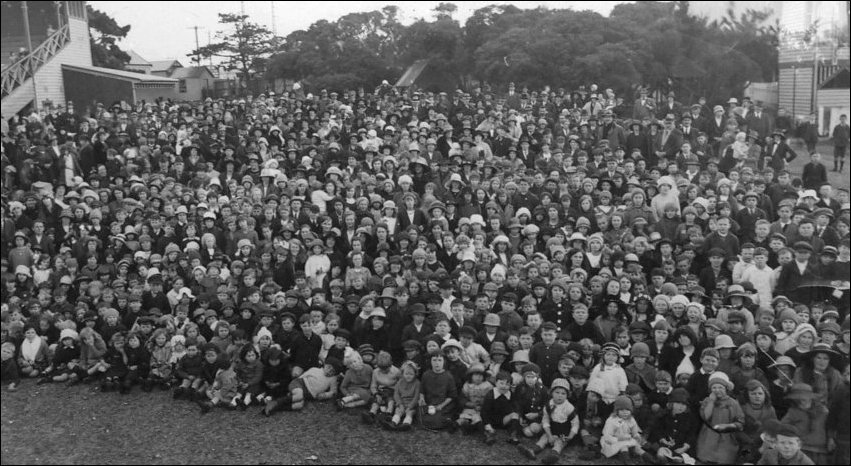
Chelsea State School Picnic at the Aspendale Racecourse, 1922. Courtesy of Chelsea and District Historical Society.
Frank Baguley remembers that they would travel from Heatherton to Mordialloc or Aspendale. They were beautiful beaches in those days, he says. “We always would travel down in the market gardeners trucks. They would have boxes all around the edge of the trucks; they had high sides, for veggies and tomatoes in those days. The boxes used to be about 2’6” long, made of slats which had gaps, and when the truck went over a bump… Oh, Gee! It used to hurt!” When they arrived, they would have to line up for sports on the beach. Volleyball, and swimming, he says. They used to have raspberry vinegar… barrels of it, he recalls with a smile, and remembers that the teachers always stopped them from swimming for an hour after their meal. The children would be screaming ‘Why? Why?’ because they didn’t believe there was any such thing as cramp, but the teachers would line them all up and wouldn’t let anyone in. Which was good really, in hindsight, Frank admits, but at the time, they all thought it was just mean. [27]
Len Allnutt sums up his experience of schooling in the 1920s with this concise, nicely rounded observation. “The kids were frightened of the teachers, the teachers were frightened of the Boss, and the Boss was frightened of the District Inspector. That’s how it used to work.” [28] But he also remembers his schooldays for the fact that there were many, many lifelong friendships made and kept sacred throughout the years. Perhaps the Truth did in fact, Prevail, and the children really did heed the words, “Never Betray a Trust,” to form a caring, close-knit and thriving community. [29]
Footnotes

